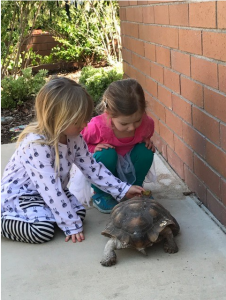An evolving Outdoor Classroom at The Gillispie School in La Jolla, San Diego, CA
 by Sonya McIntyre on May 24, 2017 for Storypark: excerpts from her inspiring article
by Sonya McIntyre on May 24, 2017 for Storypark: excerpts from her inspiring article
… We initially thought of our move outside as a short-term solution that would buy us time as we sought support services for our student, but within the first week, we began noticing all of the potentials of the outdoor space. Our ‘Outdoor Classroom’ had been there all along but, like most things in nature, it had just needed some tender loving care to flourish. Being outside for hours at a time inspired more exploration, inquiry, collaboration, and learning than we usually saw inside our classroom. Our student, as well as the whole class, was thriving.
Children are natural scientists; all day long they are investigating, hypothesizing, testing theories, and learning about their world. For all of its perceived shortcomings, our outdoor environment actually offered our class an abundance of opportunities to hone and master these skills. It was transformative, and children love the power and wonder of transformation. With the addition of water, their hands, their hair, and their entire bodies could go from dry to wet; they could transform the dusty dirt in the digging area into squishy mud perfect for “magic potions”; they could use a paintbrush and a tin cup of water to color the concrete with designs or “wash” the trikes and play structure; they could pour water into the sandbox and create rivers and lakes. These kinds of explorations were limited in our classroom, but not so outdoors.
The children connected with nature in authentic ways, exploring sights and smells and textures. Throughout the morning we could find them basking in the sun as they sat and enjoyed a snack with a friend; laying down with binoculars watching the clouds go by; shoveling through layers of dirt in the digging area to unearth hidden roots and seeds; running up and then rolling down the small hill between the elementary and Early Childhood campuses; making jewelry out of sticks and beads found in the sandbox; immersing their hands and feet in mud; observing the many caterpillars growing in the garden boxes; practicing, over and over, how to climb the Rosewood trees all by themselves. Through these interactions with nature, the children were developing a love and respect for the natural world around them and paying less attention to the manmade play structure in the middle of our yard.
As we look back on the school year, where we started and where we are ending, we are so thankful for this child and how his needs helped shape our year and our teaching. One of the principles of the Reggio Emilia philosophy is that the environment is the third teacher, as influential as parents and educators. What do you do, though, when a child does not thrive in your environment when their needs are not being met? When it comes to children’s behavior, one of our mottos is, “It’s not the child, it’s the environment.” It is a child’s right to be provided the most supportive environment possible. Once we reflected on what the most supportive environment for our student was, we committed to changing our practices. We didn’t realize that giving our student what he needed would also give the other children so much more of what they needed, too. It’s always our goal to be reflective and co-learn alongside the children; this year has reinforced the importance of always being reflective and looking at challenging situations as opportunities to grow and learn. If we expect that of our students, we should expect that of ourselves. We were inspired to cultivate our outdoor classroom and make the most of all the possibilities within it. We, our students, and our colleagues and their students, were energized by the changes and will be reaping the rewards of our evolving ‘Outdoor Classroom’ for years to come.
Read the entire article here
